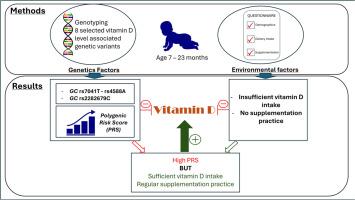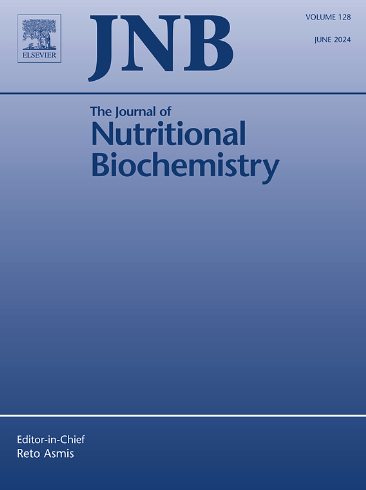Association between polygenic risk scores and vitamin D status among Chinese healthy infants and toddlers: The role of dietary intake and supplementation practice
IF 4.9
2区 医学
Q1 BIOCHEMISTRY & MOLECULAR BIOLOGY
引用次数: 0
Abstract
Hypovitaminosis D during infancy may adversely affect health and developmental outcomes in early childhood. Our study aims to explore the individual and combined effects of the eight selected genetic variants (rs4588, rs7041, rs2282679, rs2228570, rs1993116, rs4646536, rs11234027, and rs10783219) on vitamin D status among infants and toddlers with sufficient and insufficient vitamin D intake. A multi-centre cross-sectional study was conducted to recruit 616 infants and toddlers aged 7–23 months. A polygenic risk score (PRS) was computed from eight selected genetic variants. Questionnaire on family demographics, dietary intake and the use of vitamin D containing supplements were completed by parents. Participants’ vitamin D status was classified based on their serum 25(OH)D concentrations measured by Liquid Chromatography Tandem Mass Spectrometry. Analyses showed that rs7041T, rs4588A, and rs2282679C carriers had significantly lower serum 25(OH)D concentration. Participants were categorized by their PRS (Low: 1–4; Low Medium: 5–6; High Medium: 7–8; and High: 9–13), in which low risk group had significantly higher serum 25(OH)D concentration than other three groups (P<.05). Effect of PRS on vitamin D concentrations was mainly observed in participants with insufficient vitamin D intake and those not using vitamin D containing supplements (P<.05). Our study revealed the individual and combined effects of genetic variants on serum vitamin D concentrations. Sufficient vitamin D intake and the use of vitamin D containing supplements can help reduce the effect of genetic risk and should be emphasized in guidelines for the prevention of hypovitaminosis D in infants and toddlers.

中国健康婴幼儿多基因风险评分与维生素D状况的关系:膳食摄入和补充实践的作用
背景:婴儿期维生素D缺乏症可能对儿童早期的健康和发育结果产生不利影响。目的:本研究旨在探讨8个选定的遗传变异(rs4588、rs7041、rs2282679、rs2228570、rs1993116、rs4646536、rs11234027和rs10783219)对维生素D摄入充足和不足婴幼儿维生素D状况的个体和综合影响。方法:对616例7 ~ 23月龄婴幼儿进行多中心横断面研究。从8个选定的遗传变异中计算多基因风险评分(PRS)。由家长填写家庭人口统计、膳食摄入量和含维生素D补充剂使用情况的问卷。根据液相色谱串联质谱法测定的血清25(OH)D浓度,对参与者的维生素D状态进行分类。结果:分析显示,rs7041T、rs4588A和rs2282679C携带者血清25(OH)D浓度显著降低。参与者按照他们的PRS进行分类(低:1-4;中低:5-6;中高:7-8;其中低风险组血清25(OH)D浓度显著高于其他三组(结论:我们的研究揭示了遗传变异对血清维生素D浓度的个体和综合影响。摄入充足的维生素D和使用含有维生素D的补充剂有助于减少遗传风险的影响,在婴幼儿预防维生素D缺乏症的指导方针中应予以强调。
本文章由计算机程序翻译,如有差异,请以英文原文为准。
求助全文
约1分钟内获得全文
求助全文
来源期刊

Journal of Nutritional Biochemistry
医学-生化与分子生物学
CiteScore
9.50
自引率
3.60%
发文量
237
审稿时长
68 days
期刊介绍:
Devoted to advancements in nutritional sciences, The Journal of Nutritional Biochemistry presents experimental nutrition research as it relates to: biochemistry, molecular biology, toxicology, or physiology.
Rigorous reviews by an international editorial board of distinguished scientists ensure publication of the most current and key research being conducted in nutrition at the cellular, animal and human level. In addition to its monthly features of critical reviews and research articles, The Journal of Nutritional Biochemistry also periodically publishes emerging issues, experimental methods, and other types of articles.
 求助内容:
求助内容: 应助结果提醒方式:
应助结果提醒方式:


